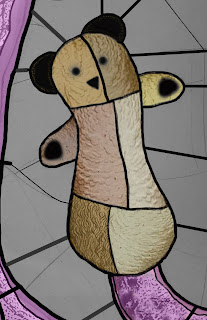Study for Sooty as an animist fetish/transitional object
Session eight was focused on painting. This time the body of the Sooty puppet and the arm it is attached to were the subjects. This is a particularly important aspect of the idea. I want to suggest that in all animist conversations, (i.e. between humans and non human entities) there is an element of the spiritual. In this case because of the specific history of stained glass I was interested in channelling depictions of the Lamb of God.
Stained glass depictions of the Lamb of God
After looking at how the fleece was depicted, I made a new study to replace my original one of a Sooty fetish. (See image at the top of this post)
A previous study for a Sooty fetish
The new study as well as exploring textural differences also changed the relationship between the fetish and the audience, this time the Sooty figure stares straight back at the viewer. The different types of glass used were also thought about and my increasing knowledge of working with water based paints as a first layer, has enabled me to have a much clearer idea of what I'm working towards.
Using water based stained glass paint I laid a graded matte to each section of the bear's body and then worked into these sections with a dry brush technique that was designed to echo how at times hair texture had been rendered historically.
Sections of the Sooty body with graded matte and hair texture applied
The pads representing the paws of the bear were done slightly differently, using a flooding technique. In order to avoid blistering when fired, when using flooding, you need to mix your paint each time you load your brush. The term 'flooding' is a good description for what happens when you touch a loaded wet brush onto the glass, the paint spreads out from the brush tip. However in my case I wasn't looking for a flat black, so varied the mixes and as the glass for one of the arm/paws was a textured one, this allowed the glass texture to come through. One other thing I was having to bear in mind was how much of the glass the leading would cover, which is why the dark pad is the size that it is.
A paw with a water based matte and dark 'flooded' pad
I had used an old piece of glass with lines fired into it for the other paw. When I was looking at old stained glass windows, I realised that there were often re-purposed glass components from earlier times. Glass is very expensive and in future I will try and recycle more, this tiny element was a reminder of this.
Finally some of these sections will have silver stain added to the back, which should harmonise all the colours and give a yellow intensity to the Sooty image, but that will have to be done on the back, so all these sections will need to be fixed by firing before then.
The next area to look at was the arm and I wanted more texture but of a very different type. Jo-Ann suggested that I explore a particular spray technique and so I did.
A texture test made by spraying water droplets over a matted surface
Using a spare piece of glass a graded matte was made using water based paint applied with a large hake brush, which was then smoothed and graded using a badger brush, as described in session six. This was dried using a hair drier and after testing that the spray was sufficiently fine, a spray diffuser was used to spray a fine mist of water over the glass. Just one short burst of spray was used, a long one would mean the water would begin to run off the surface. Again the glass was gently dried off using a hair drier. Once dry the badger brush was very lightly fanned over the surface with the faintest of contacts and as this was done gradually the texture of water droplets was revealed. Once I had grasped the technique I applied it to the two sections of pink glass that made up the arm.
The final task of the session was to return to the leg which has now been fully fired and to stop out by flooding the area between the leading and the trace line.
Paint being mixed ready to go over the trace line
A fine line drawn over the existing trace line
The first thing to do was to draw a fine line over the existing trace line. This forms a barrier to protect the rest of the glass from the flooding.
Flooding is applied between the trace line and the area that will be bounded by leading.
Then flooding was applied as it was for the pads that sit within the paws. This means that when light illuminates the leg there will be no confusion between the line of the leading and the painted line of the edge of the leg.
See also:














No comments:
Post a Comment